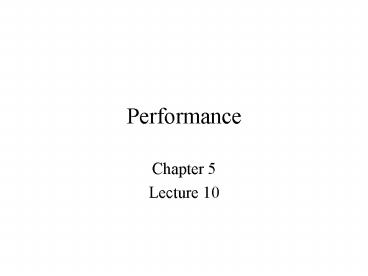Performance PowerPoint PPT Presentation
1 / 23
Title: Performance
1
Performance
- Chapter 5
- Lecture 10
2
Performance
- What does performance mean?
- What determines performance?
- How fast will it climb, how quickly will it take
off, land, or how far will it go.
3
Level of Performance
- Airframe- in-flight performance depends on its
drag characteristics. - Remember power is required to move something a
specific distance per unit or time. - Power is a force times velocity
- Power required at any given velocity is
determined by multiplying the drag times velocity.
4
Power Curve
- Plotting power drag a curve appears
- This is the power required curve or the power
curve - The power curve has nothing to do with the engine
- The curve is simply the drag curve replotted in
terms of drag - The term power required refers to the power
required for level flight
5
Power Curve
- Figure 5-1 p. 116
- A power required curve for an airplane that
indicates 200kts to fly, with a 160hp required - Remember that the rating is given in the brake
horsepower output of the engine - The actual power available for thrust is
determined by multiplying bhp x prop. efficiency
6
Figure 5-2 p. 117
- The dotted line 200 horsepower, the max. bph of
the 200 horsepower engine - Not all 200 horsepower overcame drag
- The amount available is the thp, which is the bhp
x prop efficiency - Prop efficiency is always less than one, so thp
is always less than bhp
7
Efficiency
- The efficiency is usually greatest in cruise
decreases at lower speeds - Where the power available and the power required
curves cross is the max level flight speed - Above that speed more power is required than is
available
8
Figure 5-3 p. 118
- Power curves showing max power available 75
power - Sustaining the speed demands the required amount
of power being delivered - Below that speed, increasingly more power is
required to sustain level flight
9
Back side of the power curve
- The curve changes direction and curls up on the
low speed side of the speed range - This effect is due to increased induced drag in
this region results in a reversed trend in
power requirement with airspeed
10
Back side of the power curve
- The back side of the power curve is usually very
short due to minimum power speed is low - Many airplanes stall before reaching that slow
speed
11
Climb Performance
- The airplanes ability to climb is also
determined by the power curve - Excess power is not used in level flight but is
used in a climb - Excess power is also called power differential
12
Excess Power
- The rate of climb at any speed is proportional to
the amount of excess power - This is inversely proportional to weight
- Figure 5-4 shows the power required curve the
maximum power available curve with max power
13
Power Curves
- Figure 5-4 p. 120
- Figure 5-5 p. 121
- Figure 5-6 p. 122
- Figure 5-7 p. 122
14
Vx Vy
- When do you use Vx Vy?
- How are Vx Vy different?
- Figure 5-8 p. 123
15
Terms
- Calibrated Airspeed
- Ceiling
- No more excess power climbing ability is zero
- Absolute Ceiling
- Point where the curves touch is required for
level flight - Service Ceiling
- Rate of climb is only 100fpm
16
Power Curves
- Figure 5-9 p. 124
- Figure 5-10 p. 125
- Figure 5-11 p. 125
17
Twin Engine Climb Performance
- The power required is divided into two engines
- Figure 5-13 p. 127
- Twin that looses 50 looses up to 80 of
performance and up to 90 of climb rate - This is due to loss of power, asymmetric thrust
adds to drag climbing even harder
18
Descent Glide Performance
- When there is a negative difference in power we
get a negative climb rate - Sinking and the resulting vertical velocity is
called rate of sink - Minimum rate of sink does not necessarily mean
the best overall glide performance. - At a very low airspeed, the aircraft is moving
slowly at minimum sink speed
19
Glide
- The maximum glide distance would be obtained at
the minimum ratio of rate of sink to forward
speed - This speed corresponds to the point were power
velocity touch - This is best glide speed
- Figure 5-16 p. 130
20
Glide Ratio
- The ratio of horizontal to vertical distance for
a given amount of altitude - Glide distance altitude x L/D
21
Time Distance
- Range
- Endurance
- Cruise Efficiency
22
Quiz on Lecture 10Chapter 5
- Please take out a sheet of paper
- Include todays date your name
23
Quiz on Lecture 10Chapter 5
- Describe the back side of the power curve.
- Compare and contrast absolute ceiling and service
ceiling. - How do you determine glide distance?

